高中英语动名词和不定式的区别
- 格式:doc
- 大小:89.05 KB
- 文档页数:23
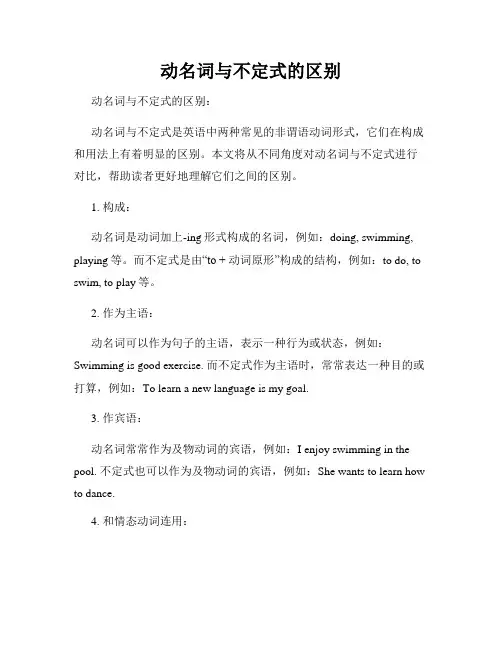
动名词与不定式的区别动名词与不定式的区别:动名词与不定式是英语中两种常见的非谓语动词形式,它们在构成和用法上有着明显的区别。
本文将从不同角度对动名词与不定式进行对比,帮助读者更好地理解它们之间的区别。
1. 构成:动名词是动词加上-ing形式构成的名词,例如:doing, swimming, playing等。
而不定式是由“to + 动词原形”构成的结构,例如:to do, to swim, to play等。
2. 作为主语:动名词可以作为句子的主语,表示一种行为或状态,例如:Swimming is good exercise. 而不定式作为主语时,常常表达一种目的或打算,例如:To learn a new language is my goal.3. 作宾语:动名词常常作为及物动词的宾语,例如:I enjoy swimming in the pool. 不定式也可以作为及物动词的宾语,例如:She wants to learn how to dance.4. 和情态动词连用:当动名词和情态动词连用时,情态动词后面必须跟动名词形式,例如:I can't stand smoking. 而不定式和情态动词连用时,情态动词后跟不定式的原形,例如:She must study hard to pass the exam.5. 表达目的:动名词常用来表达一个动作或状态的目的,例如:I went to the gym for swimming. 而不定式也可以表达目的,例如:She walked fast tocatch the bus.通过以上对比,我们可以清楚地看到动名词与不定式在用法上的区别。
在实际运用中,我们需要根据句子的语境和需要选择合适的形式,以确保句子表达准确清晰。
希望本文的对比能帮助读者更好地理解动名词与不定式之间的区别,提高英语写作和表达的能力。
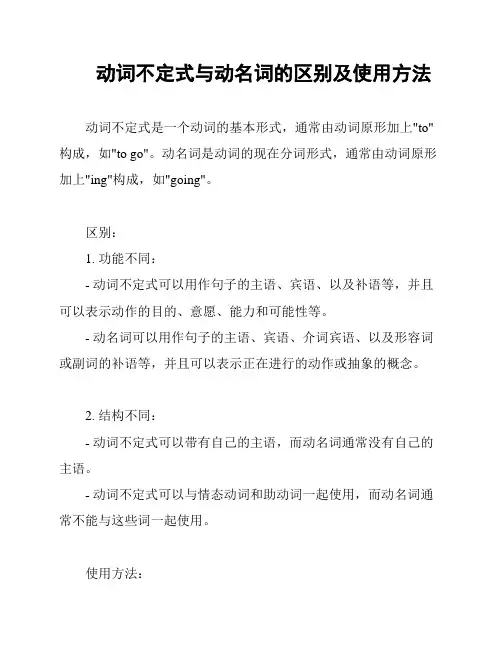
动词不定式与动名词的区别及使用方法动词不定式是一个动词的基本形式,通常由动词原形加上"to"构成,如"to go"。
动名词是动词的现在分词形式,通常由动词原形加上"ing"构成,如"going"。
区别:1. 功能不同:- 动词不定式可以用作句子的主语、宾语、以及补语等,并且可以表示动作的目的、意愿、能力和可能性等。
- 动名词可以用作句子的主语、宾语、介词宾语、以及形容词或副词的补语等,并且可以表示正在进行的动作或抽象的概念。
2. 结构不同:- 动词不定式可以带有自己的主语,而动名词通常没有自己的主语。
- 动词不定式可以与情态动词和助动词一起使用,而动名词通常不能与这些词一起使用。
使用方法:1. 动词不定式的使用:- 作主语:To travel is my dream.- 作宾语:I want to go on a vacation.- 表示目的:I study hard to pass the exam.- 表示意愿:I would like to visit my grandparents.- 表示能力和可能性:He is able to solve the problem.2. 动名词的使用:- 作主语:Swimming is a great exercise.- 作宾语:I enjoy reading books.- 作介词宾语:She is fond of playing the guitar.- 作补语:I am interested in learning new things.总结:动词不定式和动名词虽然在形式上有所区别,但在使用上都有自己独特的功能。
根据句子的需要和语境,我们可以选择合适的形式来表达我们想要表达的意思。
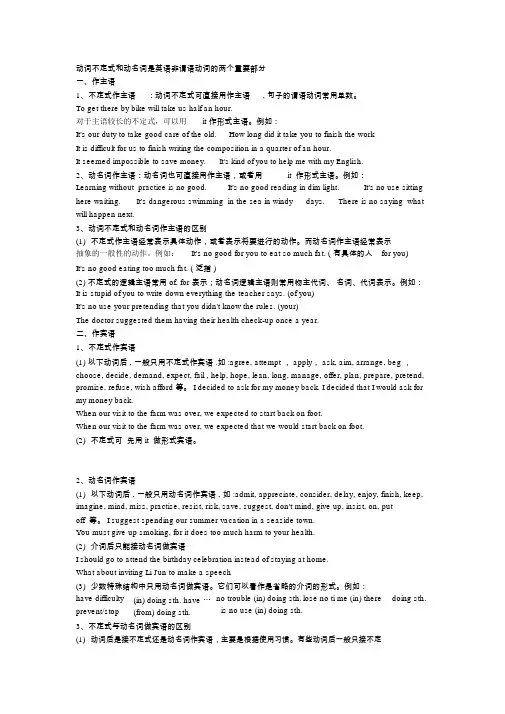
动词不定式和动名词是英语非谓语动词的两个重要部分一、作主语1、不定式作主语:动词不定式可直接用作主语, 句子的谓语动词常用单数。
To get there by bike will take us half an hour.对于主语较长的不定式,可以用it 作形式主语。
例如:It's our duty to take good care of the old.How long did it take you to finish the workIt is difficult for us to finish writing the composition in a quarter of an hour.It seemed impossible to save money.It's kind of you to help me with my English.2、动名词作主语:动名词也可直接用作主语,或者用it 作形式主语。
例如:Learning without practice is no good.It's no good reading in dim light.It's no use sitting here waiting.It's dangerous swimming in the sea in windy days.There is no saying what will happen next.3、动词不定式和动名词作主语的区别(1)不定式作主语经常表示具体动作,或者表示将要进行的动作。
而动名词作主语经常表示抽象的一般性的动作。
例如:It's no good for you to eat so much fat. ( 有具体的人for you)It's no good eating too much fat. ( 泛指 )(2) 不定式的逻辑主语常用 of, for 表示;动名词逻辑主语则常用物主代词、名词、代词表示。
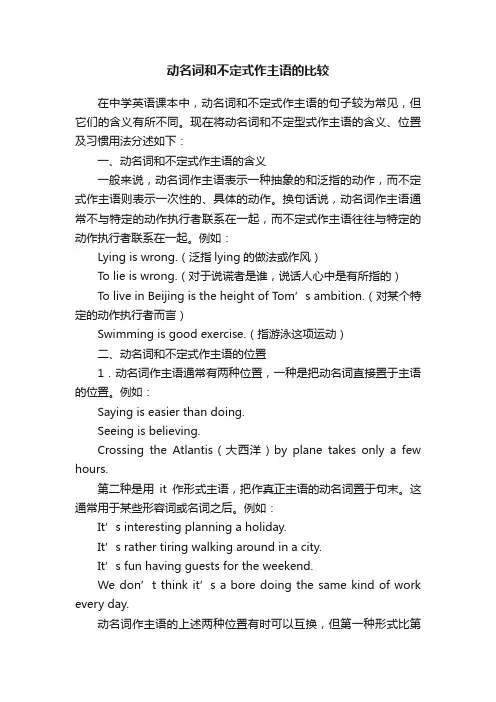
动名词和不定式作主语的比较在中学英语课本中,动名词和不定式作主语的句子较为常见,但它们的含义有所不同。
现在将动名词和不定型式作主语的含义、位置及习惯用法分述如下:一、动名词和不定式作主语的含义一般来说,动名词作主语表示一种抽象的和泛指的动作,而不定式作主语则表示一次性的、具体的动作。
换句话说,动名词作主语通常不与特定的动作执行者联系在一起,而不定式作主语往往与特定的动作执行者联系在一起。
例如:Lying is wrong.(泛指lying的做法或作风)To lie is wrong.(对于说谎者是谁,说话人心中是有所指的)To live in Beijing is the height of Tom’s ambition.(对某个特定的动作执行者而言)Swimming is good exercise.(指游泳这项运动)二、动名词和不定式作主语的位置1.动名词作主语通常有两种位置,一种是把动名词直接置于主语的位置。
例如:Saying is easier than doing.Seeing is believing.Crossing the Atlantis(大西洋)by plane takes only a few hours.第二种是用it作形式主语,把作真正主语的动名词置于句末。
这通常用于某些形容词或名词之后。
例如:It’s interesting planning a holiday.It’s rather tiring walking around in a city.It’s fun having guests for the weekend.We don’t think it’s a bore doing the same kind of work every day.动名词作主语的上述两种位置有时可以互换,但第一种形式比第二种形式的泛指意义更强些。
例如:Lining in Beijing must be wonderfulIt must be wonderful living in Beijing2.不定式作主语通常也有两种位置,与动名词作主语时的位置相同,即第一种是把不定式作直接置于句首担任主语。
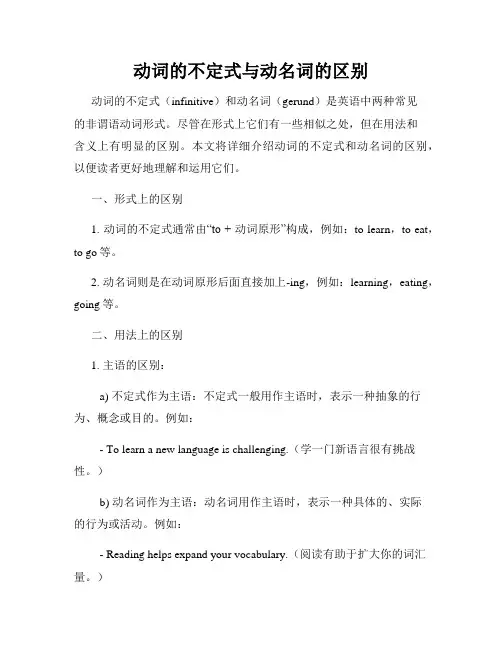
动词的不定式与动名词的区别动词的不定式(infinitive)和动名词(gerund)是英语中两种常见的非谓语动词形式。
尽管在形式上它们有一些相似之处,但在用法和含义上有明显的区别。
本文将详细介绍动词的不定式和动名词的区别,以便读者更好地理解和运用它们。
一、形式上的区别1. 动词的不定式通常由“to + 动词原形”构成,例如:to learn,to eat,to go等。
2. 动名词则是在动词原形后面直接加上-ing,例如:learning,eating,going等。
二、用法上的区别1. 主语的区别:a) 不定式作为主语:不定式一般用作主语时,表示一种抽象的行为、概念或目的。
例如:- To learn a new language is challenging.(学一门新语言很有挑战性。
)b) 动名词作为主语:动名词用作主语时,表示一种具体的、实际的行为或活动。
例如:- Reading helps expand your vocabulary.(阅读有助于扩大你的词汇量。
)2. 宾语的区别:a) 不定式作为宾语:不定式可以作为及物动词或不及物动词的宾语,常用于某些动词后,例如:want,hope,decide等。
例如: - She wants to learn Chinese.(她想学中文。
)b) 动名词作为宾语:动名词一般用作及物动词的宾语,常用于某些动词后,例如:enjoy,like,dislike等。
例如:- He enjoys swimming in the ocean.(他喜欢在海里游泳。
)3. 表语的区别:a) 不定式作为表语:不定式可以用作表语,通常用于表示完成、未来或可能性等。
例如:- His dream is to become a doctor.(他的梦想是成为一名医生。
)b) 动名词作为表语:动名词不常用作表语。
4. 定语的区别:a) 不定式作为定语:不定式可以用作修饰名词或代词的定语,常用于表示目的、原因或解释等。
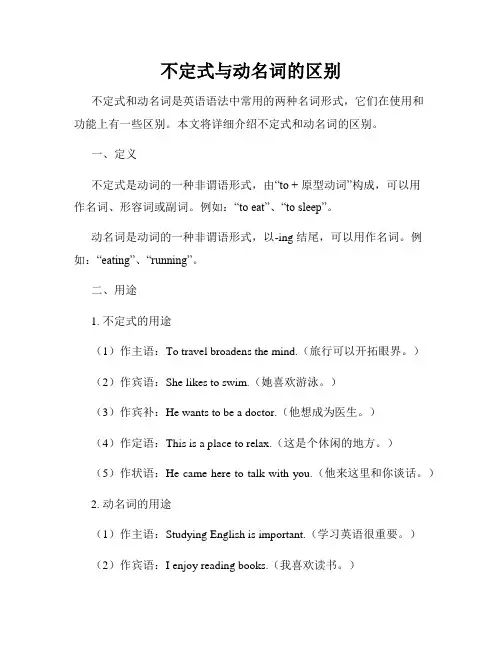
不定式与动名词的区别不定式和动名词是英语语法中常用的两种名词形式,它们在使用和功能上有一些区别。
本文将详细介绍不定式和动名词的区别。
一、定义不定式是动词的一种非谓语形式,由“to + 原型动词”构成,可以用作名词、形容词或副词。
例如:“to eat”、“to sleep”。
动名词是动词的一种非谓语形式,以-ing 结尾,可以用作名词。
例如:“eating”、“running”。
二、用途1. 不定式的用途(1)作主语:To travel broadens the mind.(旅行可以开拓眼界。
)(2)作宾语:She likes to swim.(她喜欢游泳。
)(3)作宾补:He wants to be a doctor.(他想成为医生。
)(4)作定语:This is a place to relax.(这是个休闲的地方。
)(5)作状语:He came here to talk with you.(他来这里和你谈话。
)2. 动名词的用途(1)作主语:Studying English is important.(学习英语很重要。
)(2)作宾语:I enjoy reading books.(我喜欢读书。
)(3)作宾补:I consider it worth trying.(我认为值得一试。
)(4)作定语:She's afraid of flying.(她害怕坐飞机。
)(5)作状语:He made money by selling paintings.(他靠卖画赚钱。
)三、区别与辨析1. 动作性与名词性不定式具有动词的动作性质,可以表示动作的进行或完成;动名词则具有名词的性质,可以作主语、宾语等。
比较:(1)I want to go to the park.(不定式作宾语,表示目的)(2)Going to the park is my favorite activity.(动名词作主语,表示活动本身)2. 是否能够接宾语不定式可以接宾语,通常在“动词+宾语+不定式”结构中用于表示一个完整的动作;动名词不能直接接宾语,需要借助介词来连接。

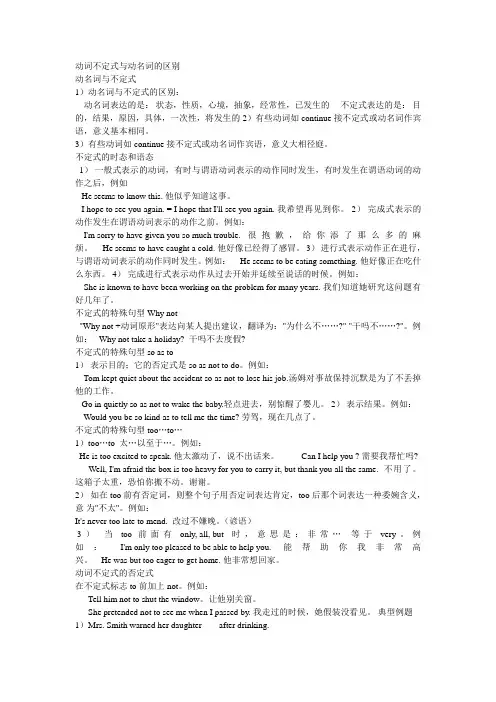
动词不定式与动名词的区别动名词与不定式1)动名词与不定式的区别:动名词表达的是:状态,性质,心境,抽象,经常性,已发生的不定式表达的是:目的,结果,原因,具体,一次性,将发生的 2)有些动词如continue接不定式或动名词作宾语,意义基本相同。
3)有些动词如continue接不定式或动名词作宾语,意义大相径庭。
不定式的时态和语态1)一般式表示的动词,有时与谓语动词表示的动作同时发生,有时发生在谓语动词的动作之后,例如He seems to know this. 他似乎知道这事。
I hope to see you again. = I hope that I'll see you again. 我希望再见到你。
2)完成式表示的动作发生在谓语动词表示的动作之前。
例如:I'm sorry to have given you so much trouble. 很抱歉,给你添了那么多的麻烦。
He seems to have caught a cold. 他好像已经得了感冒。
3)进行式表示动作正在进行,与谓语动词表示的动作同时发生。
例如: He seems to be eating something. 他好像正在吃什么东西。
4)完成进行式表示动作从过去开始并延续至说话的时候。
例如:She is known to have been working on the problem for many years. 我们知道她研究这问题有好几年了。
不定式的特殊句型Why not"Why not +动词原形"表达向某人提出建议,翻译为:"为什么不……?" "干吗不……?"。
例如: Why not take a holiday? 干吗不去度假?不定式的特殊句型so as to1)表示目的;它的否定式是so as not to do。

动词不定式与动名词的区别:
to+V 放句首为动词不定式,用法与V+ing差不多,多用于后面所说的事情还没有发生。
例:To be a author is my dream.
V+ing 放句首是动名词,其相当于名词,例:Doing lots of exercise is good for health.
一般来讲,to+ v. 表主动,表将来,表一次行动作。
-ing 表主动,表进行。
动词不定式与动名词的一些用法:
不定式与动名词都可以在句中作主语、宾语、表语和定语,但用法不尽相同。
1.作主语
一般情况下,不定式与动名词作主语可以互换,也常常可以用it充当形式主语,而把不定式和动名词放在句子的后半部分。
但二者也有区别,不定式常常指某次具体的、将要发生的行为;而动名词则表示一般的、抽
象的行为。
例如:
To save money now is not easy. 现在攒钱不容易。
Saving money is a good habit. 攒钱是个好习惯。
2.作定语
不定式多为后置定语,动名词多为前置定语;不定式多表示将来的动作,动名词只能表示事物的属性、用途等。
例如:
He is looking for a room to live in.他正在找一间房子去住。
Take these sleeping pills and you\'ll sleep better. 吃了这种安眠药,你会睡得更好。
3.作宾语:
有些动词后只能跟不定式作宾语,不能跟动名词作宾语;有些动词后常跟动名词作宾语,不能跟不定式作宾语。
有的两个皆可。
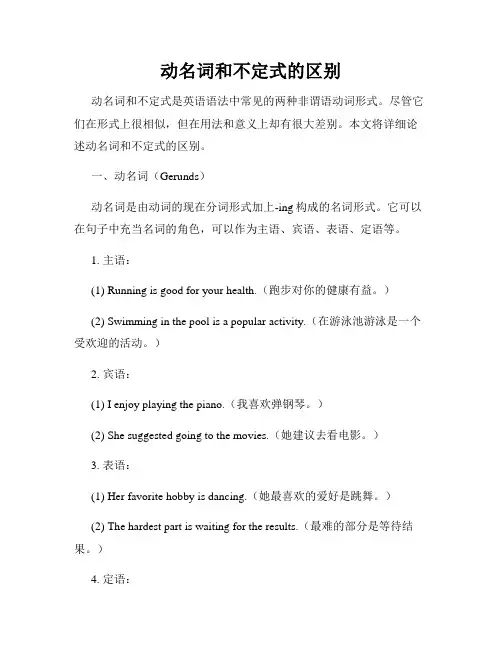
动名词和不定式的区别动名词和不定式是英语语法中常见的两种非谓语动词形式。
尽管它们在形式上很相似,但在用法和意义上却有很大差别。
本文将详细论述动名词和不定式的区别。
一、动名词(Gerunds)动名词是由动词的现在分词形式加上-ing构成的名词形式。
它可以在句子中充当名词的角色,可以作为主语、宾语、表语、定语等。
1. 主语:(1) Running is good for your health.(跑步对你的健康有益。
)(2) Swimming in the pool is a popular activity.(在游泳池游泳是一个受欢迎的活动。
)2. 宾语:(1) I enjoy playing the piano.(我喜欢弹钢琴。
)(2) She suggested going to the movies.(她建议去看电影。
)3. 表语:(1) Her favorite hobby is dancing.(她最喜欢的爱好是跳舞。
)(2) The hardest part is waiting for the results.(最难的部分是等待结果。
)4. 定语:(1) I have a painting class every Tuesday.(我每周二有一节绘画课。
)(2) The running shoes are on sale.(跑鞋正在打折。
)二、不定式(Infinitives)不定式是由to加上动词原形构成的形式。
不定式可以在句子中充当动词、形容词或名词的角色,可以作为动词、定语、表语等。
1. 动词:(1) She wants to learn a new language.(她想学一门新语言。
)(2) They decided to go on a trip together.(他们决定一起去旅行。
)2. 定语:(1) I need a pen to write the report.(我需要一支笔来写报告。
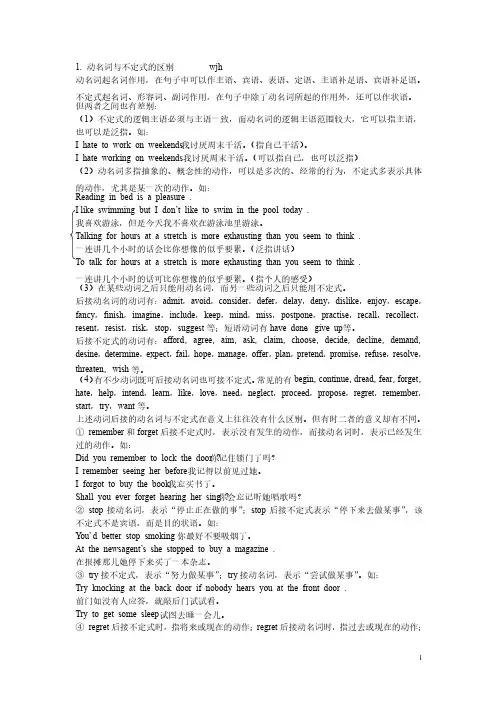
1. 动名词与不定式的区别动名词与不定式的区别 wjh 动名词起名词作用,在句子中可以作主语、宾语、表语、定语、主语补足语、宾语补足语。
不定式起名词、形容词、副词作用,在句子中除了动名词所起的作用外,还可以作状语。
不定式起名词、形容词、副词作用,在句子中除了动名词所起的作用外,还可以作状语。
但两者之间也有差别:但两者之间也有差别:(1)不定式的逻辑主语必须与主语一致,而动名词的逻辑主语范围较大,它可以指主语,也可以是泛指。
如:也可以是泛指。
如:I hate to work on weekends . 我讨厌周末干活。
(指自己干活)。
I hate working on weekends . 我讨厌周末干活。
(可以指自己,也可以泛指)(可以指自己,也可以泛指)(2)动名词多指抽象的、概念性的动作,可以是多次的、经常的行为,不定式多表示具体的动作,尤其是某一次的动作。
如:的动作,尤其是某一次的动作。
如:Reading in bed is a pleasure . I like swimming but I don’t like to swim in the pool today .我喜欢游泳,但是今天我不喜欢在游泳池里游泳。
我喜欢游泳,但是今天我不喜欢在游泳池里游泳。
Talking for hours at a stretch is more exhausting than you seem to think . 一连讲几个小时的话会比你想像的似乎要累。
(泛指讲话)(泛指讲话)To talk for hours at a stretch is more exhausting than you seem to think . 一连讲几个小时的话可比你想像的似乎要累。
(指个人的感受)(指个人的感受)(3)在某些动词之后只能用动名词,而另一些动词之后只能用不定式。
)在某些动词之后只能用动名词,而另一些动词之后只能用不定式。
动词不定式和动名词的用法和区别详解动词不定式是由动词原形加上to构成的形式,通常作为动词、形容词或副词的宾语、补语、定语或状语。
动词不定式可以表示目的、结果、愿望、能力、需要、义务等含义。
动名词是由动词加上-ing构成的形式,可以作为名词的主语、宾语、定语或表语。
动名词通常表示行为或状态的持续性或重复性。
两者的区别如下:1. 形式上的区别:- 动词不定式以to开头,如to eat、to sleep。
- 动名词以-ing结尾,如eating、sleeping。
2. 用法上的区别:- 动词不定式通常用作动词的宾语,如I want to eat。
它可以跟在某些动词后面,如want、like、hope等,构成不定式短语。
- 动名词通常可以用作名词的主语、宾语或表语,如Smokingis bad for health。
3. 意义上的区别:- 动词不定式强调的是动作的目的、结果、愿望、能力等。
例如,I want to learn English。
在这个句子中,不定式to learn强调的是想要研究英语的目的。
- 动名词强调的是动作的持续性或重复性。
例如,I enjoy swimming。
在这个句子中,动名词swimming强调的是游泳这个持续性的动作带来的愉悦感。
需要注意的是,有些动词后既可以接动词不定式,也可以接动名词,但意义可能会有所不同。
例如,I like swimming和I like to swim的意思虽然都是“我喜欢游泳”,但前者强调的是游泳这个动作本身,而后者强调的是我想要做游泳这个动作。
总结起来,动词不定式和动名词在形式、用法和意义上存在一些区别。
了解这些区别有助于我们正确使用它们,并更好地理解英语句子的含义和表达方式。
参考资料:- 李强,牛津英语语法详解,外语教学与研究出版社,2001年。
动名词和不定式的区别与用法动名词和不定式是英语中常见的两种动词形式,它们在用法和含义上有一些区别。
本文将从几个方面探讨动名词和不定式的区别与用法。
一、形式上的区别动名词是动词加上-ing形式构成的名词,例如:swimming, reading。
而不定式则是由to加上动词原形构成的,例如:to swim, to read。
二、用法上的区别1. 主语动名词可以作为句子的主语,例如:Swimming is my favorite hobby. 不定式一般不能作为句子的主语,但可以通过在前面加上it来作为形式主语,例如:It is important to learn English.2. 宾语动名词可以作为动词的宾语,例如:I enjoy swimming. 不定式也可以作为动词的宾语,例如:I want to go shopping.3. 表语动名词可以作为系动词的表语,例如:Her favorite activity is dancing. 不定式不能作为系动词的表语。
4. 定语动名词可以作为名词的定语,例如:I bought a swimming pool. 不定式也可以作为名词的定语,例如:I have a book to read.5. 动词后的宾语动名词可以直接跟动词后的宾语,例如:She enjoys swimming pools. 不定式一般需要用介词来连接动词后的宾语,例如:She wants to go to the swimming pool.6. 动词的完成形式动名词可以和完成时态连用,例如:I regret not studying harder. 不定式不能和完成时态连用,例如:I regret not to have studied harder.三、意义上的区别1. 动名词表示正在进行的动作或习惯性的动作,强调动作本身。
例如:I enjoy swimming. (我喜欢游泳)2. 不定式表示将来的动作或目的,强调动作的目的或意图。
常用句型动名词与不定式的区别动名词和不定式作为英语语法中常用的词组形式,经常被用于表达特定的含义和语境。
本文将重点介绍动名词与不定式的区别,以帮助读者更好地理解和使用这两种句型。
一、定义和形式1. 动名词(Gerund)是动词的一种形式,以-ing结尾,并且在句中充当名词的角色。
动名词的形式为动词的原形 + -ing,例如:reading, swimming, studying等。
2. 不定式(Infinitive)是动词的一种形式,一般由“to + 动词原形”构成。
例如:to read, to swim, to study等。
二、句法用法1. 主语和宾语(1)动名词作为主语,常用于表达一般性的或已经完成的动作。
例如:Swimming is my favorite hobby.(游泳是我最喜欢的爱好。
)(2)不定式作为主语,常用于表达将来的或可能的动作。
例如:To travel around the world is my dream.(环游世界是我的梦想。
)(3)动名词作为宾语,常用于及物动词之后。
例如:I enjoy swimming in the ocean.(我喜欢在海洋中游泳。
)(4)不定式作为宾语,常用于及物动词之后,并带有to。
例如:She wants to go shopping this weekend.(她想在这个周末去购物。
)2. 补语(1)动名词作为补语,常用于及物动词之后。
例如:I find it interesting watching movies.(我发现看电影很有趣。
)(2)不定式作为补语,常用于及物动词之后,并带有to。
例如:She considers him to be a good friend.(她认为他是个好朋友。
)3. 定语和状语(1)动名词作为定语,修饰名词。
例如:I have a swimming lesson tomorrow.(我明天有一节游泳课。
不定式和动名词的区别1.不定式和动名词作主语的区别(1)动名词作主语通常表示抽象动作;而不定式作主语表示具体动作。
(2)动名词作主语时,通常用以表示一件已知的事或经验;不定式短语通常用来表示一件未完成的事或目的。
(3)不定式做主语,一般用it当形式主语,把作主语的不定式短语后置。
2.不定式、动名词和分词作表语的区别(1)不定式作表语1)不定式作表语一般表示具体动作,特别是表示将来的动作。
2)如果主语是不定式(表示条件),表语也是不定式(表示结果)。
3)如果主语是以aim,duty,hope,idea,happiness,job,plan,problem,purpose,thing,wish等为中心的名词,或以what引导的名词性从句,不定式作表语是对主语起补充说明作用。
(2)动名词作表语:动名词作表语,表示抽象的一般性的行为。
3.不定式和动名词作宾语的区别英语中大多数动词既可跟不定式,也可跟动名词作直接宾语,但有些动词要求:(1)不定式做宾语和宾语补足语1)下面的动词要求不定式做宾语打算(intend)计划(plan)和期盼(expect/desire)假装(pretend)喜欢(would like/love/prefer/like)祝愿(hope/wish)决定(decide)同意(agree)帮助(help) 记得(remember)设法(manage)说服(persuade)拒绝(refuse)好像(seem/appear)答应(promise)努力(attempt)选择(choose)询问(ask)学习(learn) 忘记(forget)告诉(tell)失败(fail)付得起(afford)想要(want) 试图(try)需要(need)开始(begin/start)2)下面的动词要求不定式做宾补:动词+宾语+动词不定式ask, get, tell, like, order, want, teach, wish, would like 后跟不定式用作宾补时,需带上to。
不定式和动名词的区别和联系1)动名词与不定式的区别:动名词表达的是:状态,性质,心境,抽象,经常性,已发生的不定式表达的是:目的,结果,原因,具体,一次性,将发生的不定式与动名词都可以在句中作主语、宾语、表语和定语,但用法不尽相同。
一、作主语一般情况下,不定式与动名词作主语可以互换,也常常可以用it充当形式主语,而把不定式和动名词放在句子的后半部分。
但二者也有区别,不定式常常指某次具体的、将要发生的行为;而动名词则表示一般的、抽象的行为。
例如:To save money now is not easy. 现在攒钱不容易。
Saving money is a good habit. 攒钱是个好习惯。
[真题回放]1. ________ to sunlight for too much time will do harm to one’s skin.A. ExposedB. Having exposedC. Being exposedD. After being exposed二、作宾语有些动词后只能跟不定式作宾语,不能跟动名词作宾语;有些动词后常跟动名词作宾语,不能跟不定式作宾语;有些动词后跟不定式和动名词作宾语皆可,但意思不同,另外还要熟记下面几点:1)下列短语中的to是介词,其后跟动名词,不跟不定式。
be(get) used to习惯于;look forward to盼望;pay attention to注意;get down to开始认真做;lead to通向、导致;prefer doing ... to doing ...宁愿做……而不愿做……;stick to坚持;devote one’s life(time, oneself) to献身于、致力于;object to反对;in addition to ...除……之外;on the way to ...在去……的路上、正要成为……;等等。
2)不定式除可用在except, but, besides等后作宾语之外,一般不用作介词宾语。
高中英语动名词和不定式的区别动名词与不定式1)动名词与不定式的区别:动名词表达的是:状态,性质,心境,抽象,经常性,已发生的不定式表达的是:目的,结果,原因,具体,一次性,将发生的2)接不定式或动名词,意义相同。
3)动名词与不定式语义不同的有11组:1stop to do stop doing2 forget to do forget doing3remember to do remember doing4 regret to do regret doing5cease to do cease doing6 try to do try doing7go on to do go on doing8 afraid to do afraid doing9interested to do interested doing10 mean to do mean doing11 begin/start to do begin/start doing动词不定式、动名词用法要点讲解一、作主语⒈不定式作主语动词不定式作主语时,句子的谓语动词常用单数,其位置有以下两种:(1)把不定式置于句首。
如:To get there by bike will take us half an hour.(2)用it作形式主语,把真正的主语不定式置于句后,常用于下列句式中。
如:①It+be+名词+to doIt's our duty to take good care of the old.②It takes sb+some time+to doHow long did it take you to finish the work?③It+be+形容词+for sb+to doIt is difficult for us to finish writing the composition in a quarter of an hour.④It+be+形容词+of sb+to doIt is stupid of you to write down everything the teacher says.⑤It seems(appears)+形容词+to doIt seemed impossible to save money.在句型③中,常用表示客观情况的形容词,如:difficult,easy,hard,important,impossible,necessary等;在句型④中,常用careless,clever,good,foolish,honest,kind,lazy,nice,right,silly,stup id,wise等表示赞扬或批评的词。
在不定式前的sb,可看作其逻辑主语。
这一句式有时相当于Sb is+形容词+to do句式,如:It's kind of you to help me with my English.=You are kind to help me with my English.⒉动名词作主语Learning without practice is no good.动名词作主语时,也常用It句式。
如:①It's+no good(no use,fun,a pleasure,a waste of time)+doing…It's no good reading in dim light.It's no use sitting here waiting.②It's+形容词+doingIt's dangerous swimming in the sea in windy days.这样用的形容词有expensive,nice,tiring等,但important,necessary则不适用于这种结构,应用不定式代替,如:It's important for you to keep fit.③There is no+doingThere is no saying what will happen next.在这一结构中,动名词后常带宾语,相当于"It's impossible to…"结构。
⒊动词不定式和动名词作主语的区别①不定式作主语经常表示具体动作,常与特定的动作执行者联系在一起;而动名词作主语经常表示抽象动作,经常不与特定的动作执行者联系在一起。
如:It's no good eating too much fat.It's no good for you to eat so much fat.②动名词结构作主语,可以用名词或代词属格形式作逻辑主语。
如:It's no use your pretending that you didn't know the rules.二、作宾语⒈不定式作宾语①以下动词后,只能跟不定式作宾语。
如:agree,ask,aim,arrange,choose,decide,demand,expect,fail,help,hope,lean,long,manage,offer,plan,prepare,pretend,promise,refuse, wish等,这些词大部分可接th at引导的从句。
如:I decided to ask for my money back.I decided that I would ask for my money back.When our visit to the farm was over,we expected to start back on foot.When our visit to the farm was over,we expected that we would start back on foot.②当复合宾语中的宾语是不定式时,先用形式宾语it代替不定式,把不定式置于补语之后,即:主语+动词+it+补语+to do句式。
如:We think it quite important for us to learn a foreign language well.He feels it his duty to help the poor.③介词but,except,besides+to do(do)在这种句型中,如介词前有动词do,后面应接不带to 的不定式;如无do,则接to不定式,即带do不带to,带to 不带do。
如:The enemy soldiers had no choice but to give in.On Sunday afternoon I had nothing to do but watch TV.⒉动名词作宾语①以下动词后,只能接动名词作宾语,如:admit,appreciate,consider,delay,enjoy,finish,keep,imagine,mind, miss,practise,resist,risk,save,suggest,don't mind,give up,insist,on,put off等。
如:I suggest spending our summer vacation in a seaside town.You must give up smoking,for it does too much harm to your health.②动名词作介词的宾语I should go to attend the birthday celebration instead of staying at home.What about inviting Li Jun to make a speech?动名词前的介词有时可以省略,如:have difficulty(in)doing,have no trouble(in)doing,lose no time(in)do ing,prevent/stop…(from)doing,there is no use(in)doing等。
⒊部分动词后面,既可接动词不定式,也可接动名词作宾语,意义不变。
如:begin,continue,start,hate,like,love,need,require,want等。
在need,require,want后接-ing形式,表示被动意义,也可接不定式,但要用被动形式,如:Your handwriting needsimproving(to be improved).hate,love,like接不定式表示特定的未来事件,接动名词表示目前正在进行的活动或一般的行为。
在下列情况下,一般要用不定式:①hate,like,love前有would(should)时,如:I'd like to havea cup of coffee.②当谓语动词begin,continue,start等是进行式时,如:The students are starting to work on the difficult maths problem.③begin,continue,start与know,understand等状态动词连用时,如:I soon began to understand whatwas happening.⒋advise,allow,encourage,forbid,permit等动词后接动名词作宾语,或带不定式作宾语补足语。
如:Our teachers don't permit our swimming in the lake.Our teachers don't permit us to swim in the lake.⒌部分动词后接不定式或动名词时,意义差别较大,应根据句子语境选择使用。
①forget,remember,regret后接不定式,表示现在或未来的动作,接动名词表示动作已经发生。
如:Don't forget fo post the letter for me.Have you forgotten meeting her in Beijing Airport?Remember to close the windows before you leave.I remember writing him a letter a year ago.We regret to tell you that all of you are not invited to attend the meeting.They regretted ordering these books from abroad.②mean to do打算做某事doing意味着……I meant to catch up with the early bus.This means wasting a lot of money.③try to do设法尽力做某事doing试着做某事You should try to overcome your shortcomings.Try working out the physics problem in another way.④stop to do停下一件事去做另一件事(不定式作目的状语)doing停止做某事On the way to the airport,I stopped to buy a paper.You'd better stop arguing and do as you are told.⑤can't help doing禁不住……to do不能帮助干……They couldn't help jumping up at the news.Sorry I have lots of work to do.So I can't help to make up the room for you.⑥go on to do做不同的事或不同内容的事doing继续不停地做某事,指同一动作的继续He went on to talk about world situation.他接着又谈了世界形势。